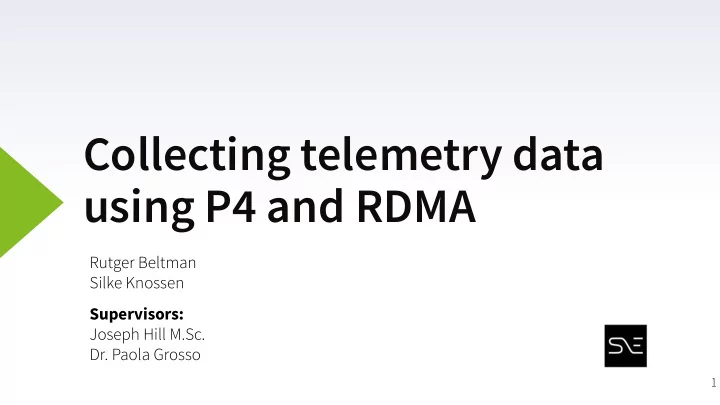

Collecting telemetry data using P4 and RDMA Rutger Beltman Silke Knossen Supervisors: Joseph Hill M.Sc. Dr. Paola Grosso 1
Introduction: Network Telemetry (I) Monitoring network health ▸ In-band network telemetry includes ▸ telemetry data in packets Delegate analyzation to multiple workers ▸ 2
Introduction: Network Telemetry (II) Requires an efficient means for collecting ▸ data Programming Protocol-independent Packet ▸ Processors (P4) for efficient telemetry data extraction Remote Direct Memory Access (RDMA) for ▸ efficient storage 3
Research Questions Can RDMA combined with P4 be used to efficiently collect telemetry data? How do we encapsulate telemetry data in an RDMA message? ▸ Can an RDMA session be maintained on a P4 switch? ▸ How can telemetry data be placed into persistent storage using RDMA? ▸ 4
DMA Data is copied from buffer 1 to the buffer 2 via the CPU ▸ CPU spends a lot of cycles copying data ▸ Delagate high throughput transfers to DMA engine ▸ CPU can continue on other tasks while the DMA ▸ engine takes care of the transfer 5
RDMA Takes concept of DMA and puts it in the NIC ▸ Allows NIC to access data directly in memory ▸ CPU sets up a write operation ▸ The NIC on host 1 reads the buffer from memory and ▸ transfers it to the other NIC The NIC of host 2 writes the data to buffer 2 ▸ The CPU is bypassed for the transfer of data ▸ 6
RoCEv1 RDMA over Converged Ethernet version 1 (RoCEv1) ▸ RoCEv1 enables RDMA over layer 2 networks ▸ GRH has the same fields as IPv6 ▸ BTH defines the RDMA operation for the NIC ▸ RETH includes memory address information for RDMA operations ▸ Invariant CRC is similar to Ethernet CRC, but slightly different ▸ 7
Related Work (I) Research by Tierney et al. (2012) compared the performance of TCP, UDP, ▸ UDT, and RoCE CPU usage in RoCE is much less in comparison to the other protocols ▹ RoCE showed consistently good performance ▹ This research shows the potential of RoCE traffic in high-throughput ▹ networks 8
Related Work (II) Research by Kim et al. (2018) examined feasibility of implementing RoCE ▸ in P4 switch Extending switch’s buffer by storing burst data remotely ▹ Extending forwarding tables by storing packet and action ▹ Remotely increase counters for telemetry data ▹ “Borrowing” memory from remote server ▸ In our approach the server will eventually process this data further into ▸ the telemetry pipeline 9
Methodology & Setup Extract telemetry data with P4 ▸ Implementing RoCE in P4 switch ▸ Send RoCE packet (RDMA write-only) with ▸ telemetry in payload Store payload on telemetry server ▸ 10
Server implementation Server uses mmap function to map virtual memory to a file on disk ▸ Set up the NIC to allow RDMA operations to the virtual memory address ▸ RDMA write-only can write directly to virtual memory, bypassing the CPU ▸ Open TCP socket to switch and share parameters required for RoCE ▸ packets 11
Switch implementation As there is no native support for RoCE on the switch, we create the RoCE ▸ headers from scratch in P4 We learned the field values from the specification and experimentation ▸ 12
Switch: specific values Most of the header field values are static ▸ Others are dynamic or based on the server’s RDMA parameters ▸ Sequence number: counter increases with each packet ▹ RDMA parameters from server are stored in a forwarding table ▹ When the packet’s egress port is to the telemetry server, ▹ there is a match in the table ▹ and the parameters are assigned to the packet ▹ The virtual memory address is increased using an offset ▹ CRC is calculated using an external function of the switch ▹ 13
Experiments (I) Experiment 1: RoCEv1 experimentation to examine headers Establishing RDMA session between the two servers using RoCE libraries ▸ Analyze parameters that are used in the application and compare them to ▸ network traffic 14
Results experiment 1 15
Experiments (II) Experiment 2: RoCEv1 switch implementation testing Sending TCP packets crafued by Scapy from the ▸ Dell server Analyzed the file on the server to analyze ▸ correctness of the implementation 16
Results experiment 2 17
Discussion No CPU involvement means CPU does not know anything about the data ▸ No signalling: signalling should provide method to let the CPU know ▸ when data can be read from memory P4 has no support for packet trailers, limiting the payload length ▸ 18
Conclusion RDMA is a feasible solution to communicate telemetry data to a collector ▸ P4 allows the original header to be encapsulated into a RoCE packet ▸ An RDMA session is maintained on the switch by keeping state of ▸ required parameters mmap provides the possibility of mapping a file to virtual memory, ▸ allowing RDMA access to this memory region 19
Future work Comparing the performance of this implementation with other techniques ▸ Data Plane Development Kit (DPDK) ▹ extended Berkeley Packet Filter (eBPF) ▹ Optimizing system performance (NVMe over Fabric instead of memory ▸ mapping) Investigate in an efficient method to signal the CPU that data can be ▸ processed further into the telemetry pipeline RDMA write-only with immediate ▹ Completing the telemetry pipeline by adding workers ▸ 20
Security implications Remote key is equivalent to a plain text password ▸ According to RFC 5040 manufacturers MUST ensure that only memory in a ▸ specific Protection Domain can be accessed. Full security considerations in RFC 5040 and RFC 5042 ▸ Throwhammer is an RDMA variant on the Rowhammer attack ▸ If properly set up, security implications similar to UDP/TCP streams (traffic ▸ injection/sniffing). 21
CRC calculation 22
References (R)DMA figures inspired on: ▸ http://www.rdmaconsortium.org/home/The_Case_for_RDMA0205 31.pdf 23
Recommend
More recommend